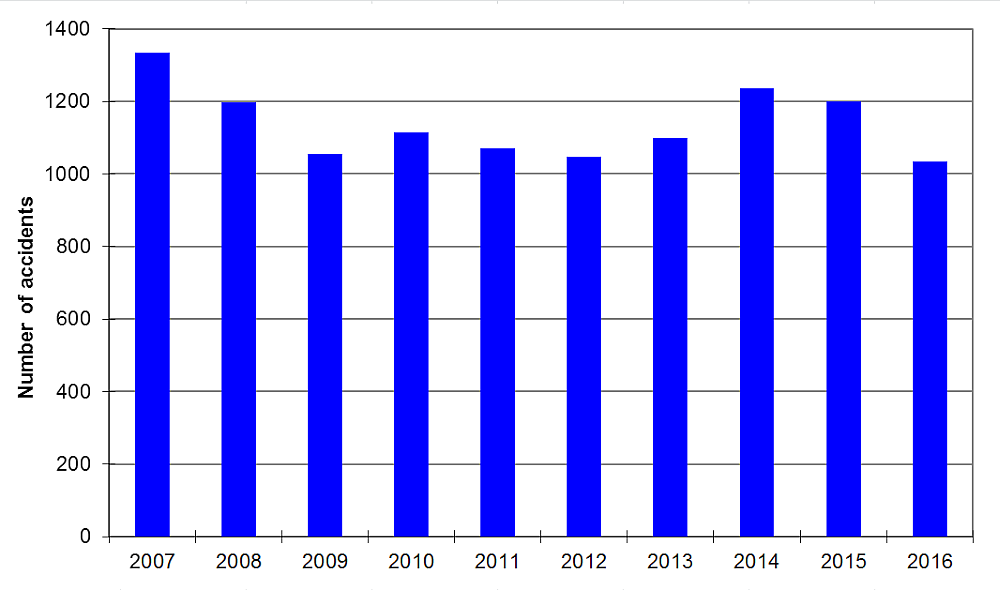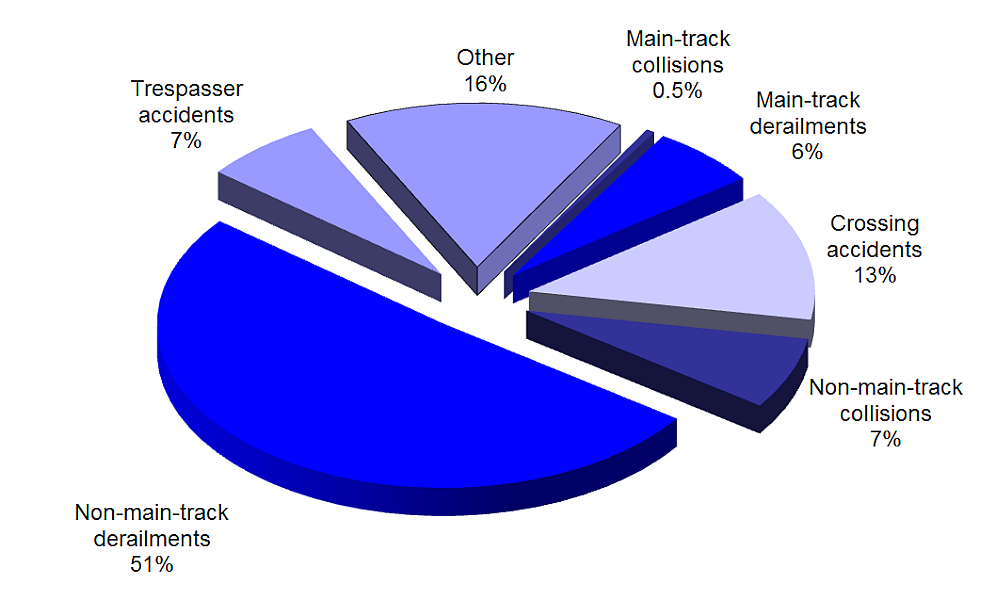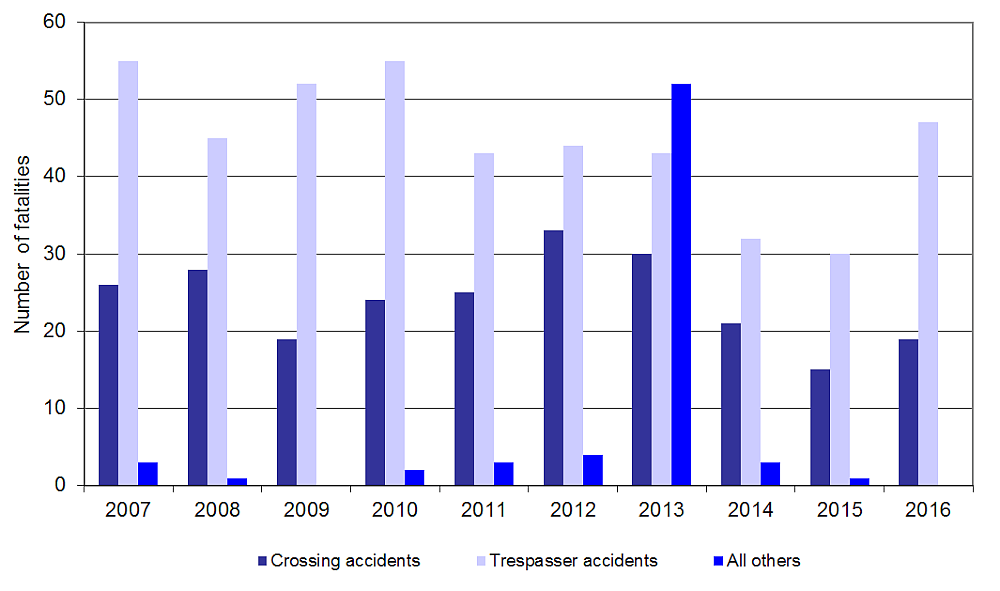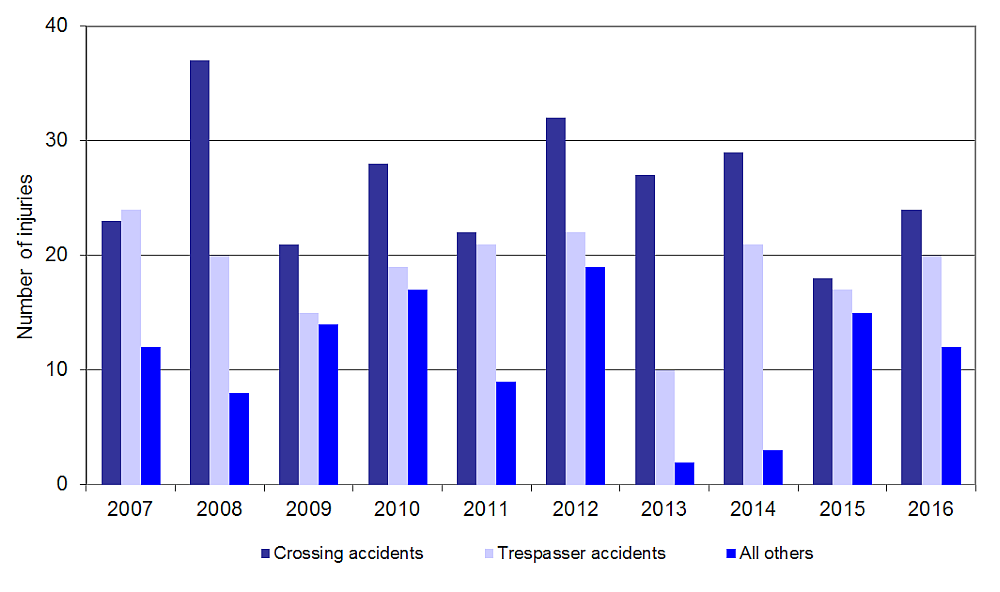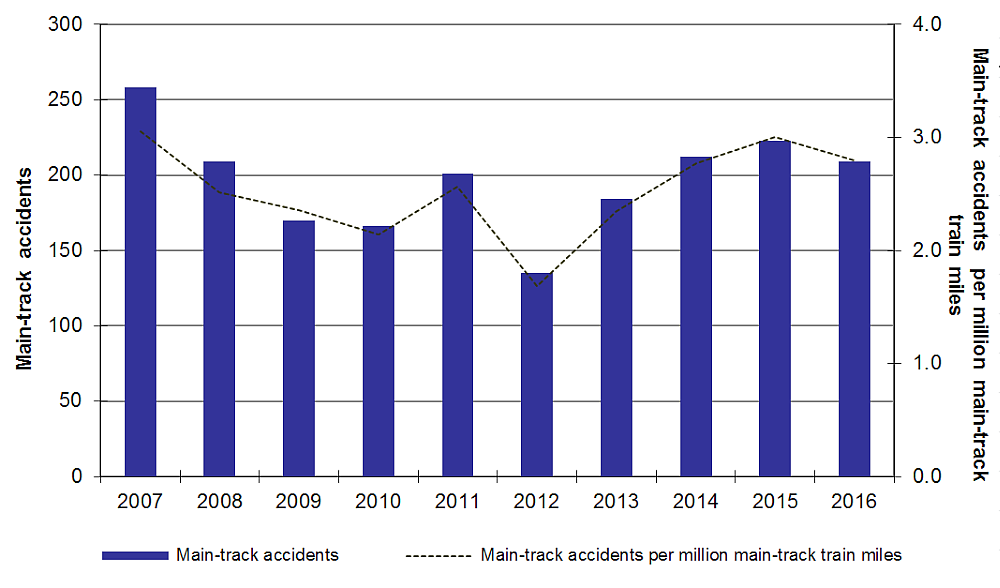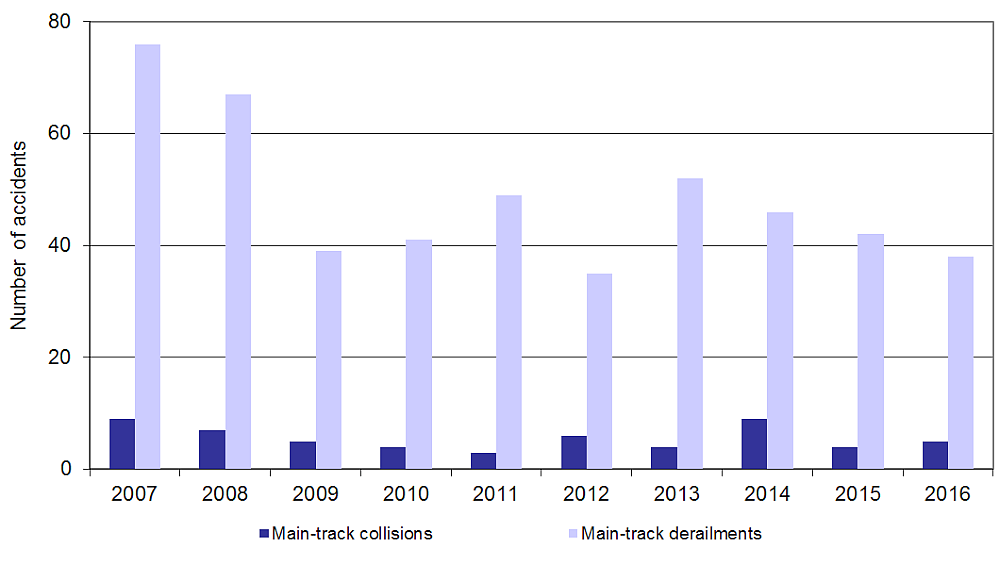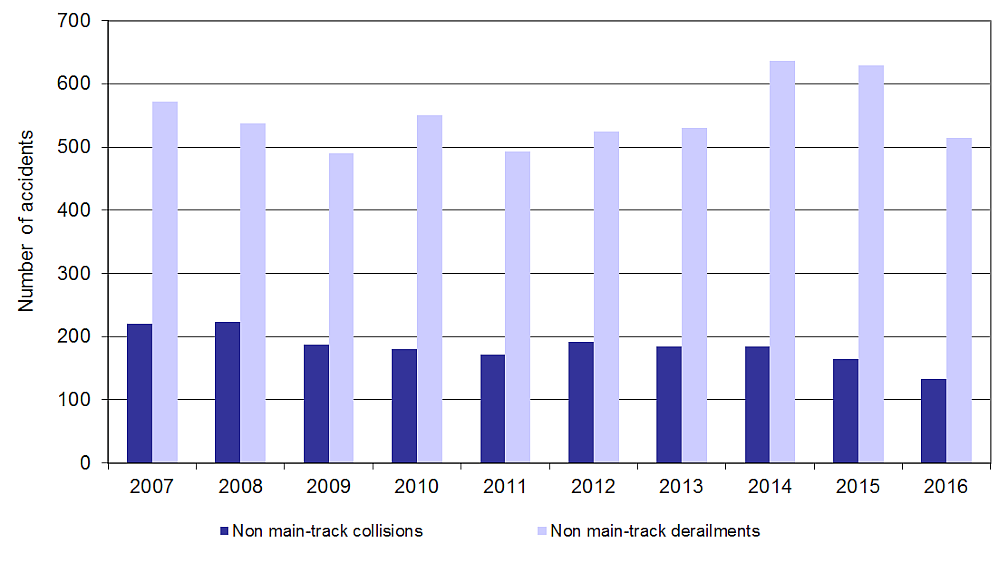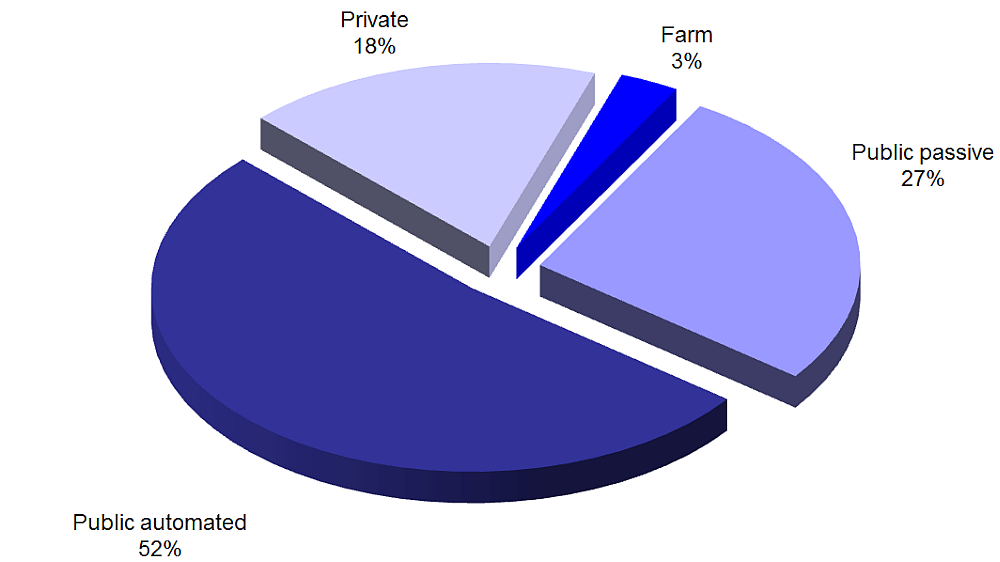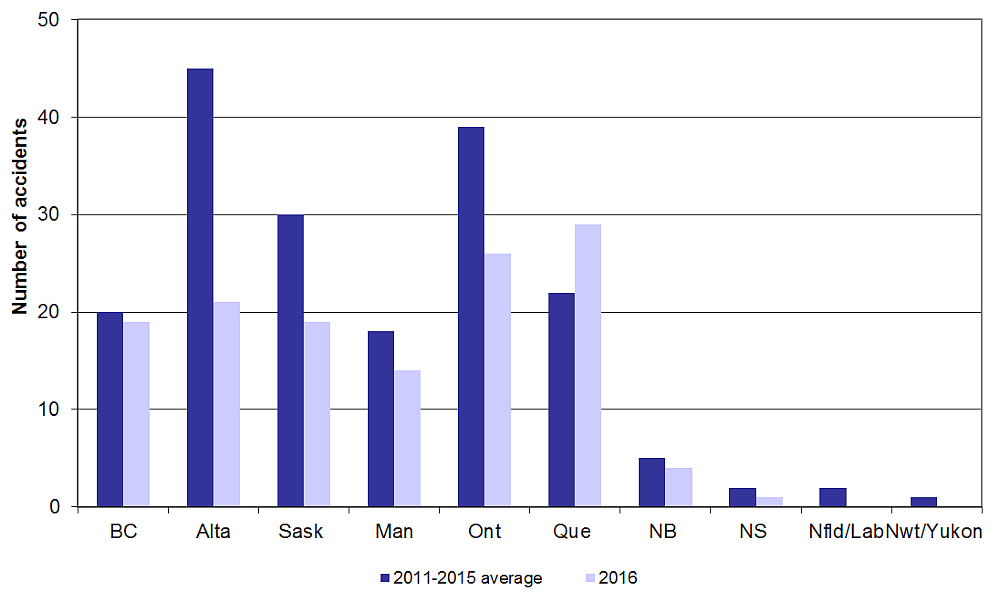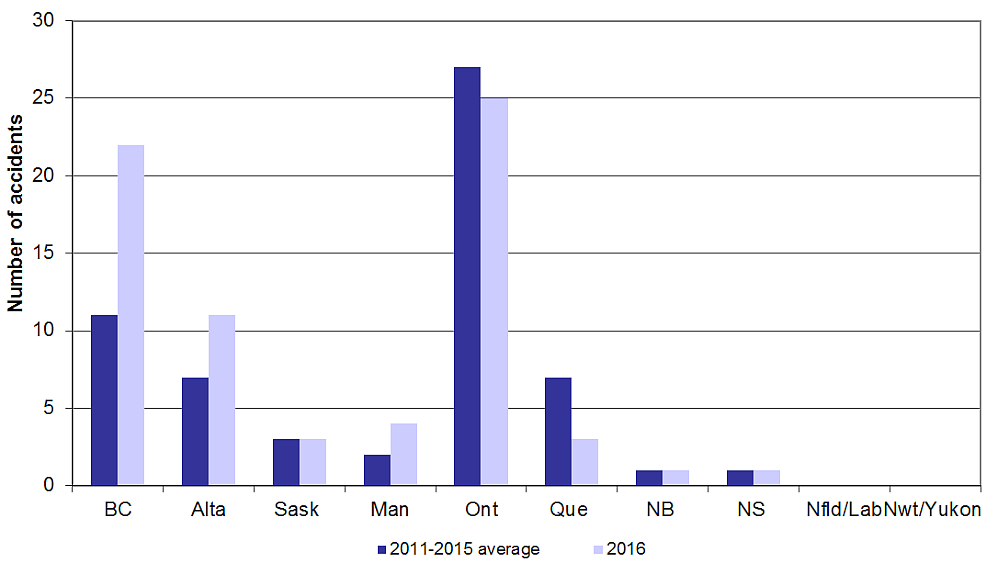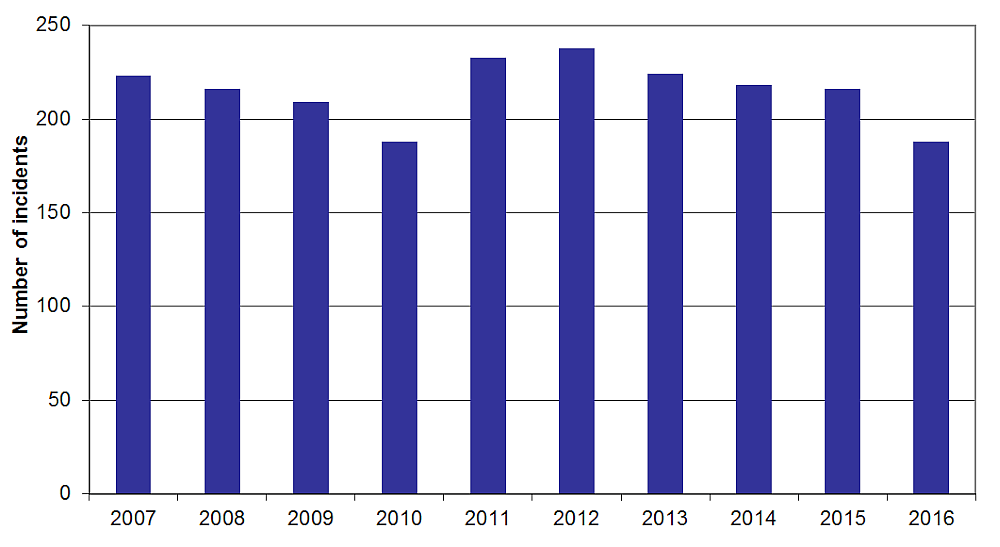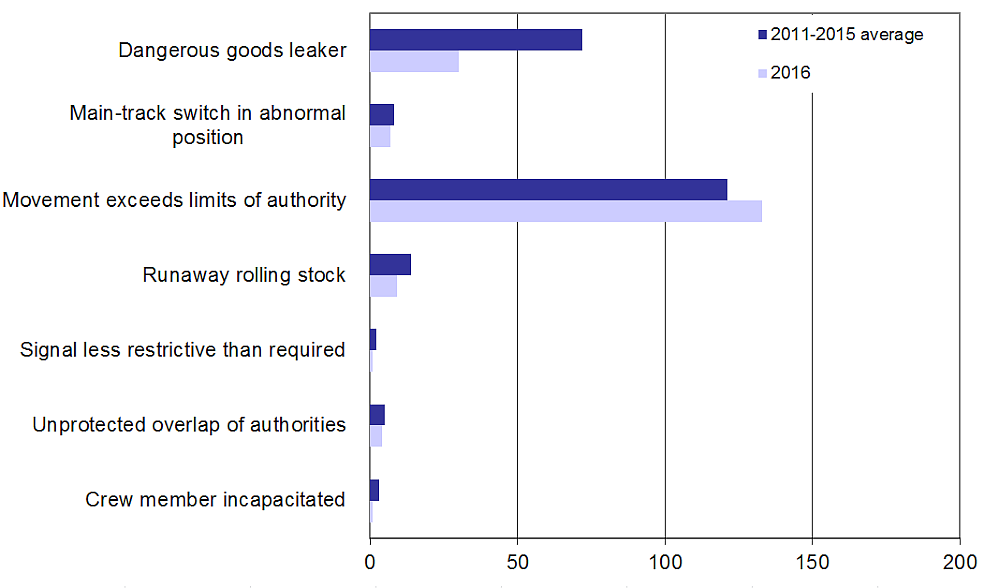Foreword
This document is a summary of selected 2016 railway safety data. It covers federally regulated railways only. Non-federally regulated data reported to the TSB are not included in this report.
The TSB gathers and uses this data during the course of its investigations to analyse safety deficiencies and identify risks in the Canadian transportation system.
The 2016 data were collected according to the reporting requirements described in the TSB Regulations in force during that calendar year.
The statistics presented here reflect the TSB database at 30 March 2017. Since the occurrence data are constantly being updated in the live database, the statistics may change slightly over time.
Also, as many occurrences are not formally investigated, information recorded on some occurrences may not have been verified.
A series of data tables associated with this annual summary is also available.
Accidents
Overview of accidents and casualties
In 2016, 1,035 rail accidentsFootnote 1 were reported to the TSB (Figure 1), a 14% decrease from the 2015 total of 1,201, a 9% decrease from the 2011-2015 average of 1,132, and a 12% decrease from the 2006-2015 average of 1,173.
Figure 1 data table
| Year | Number of accidents |
|---|---|
| 2007 | 1334 |
| 2008 | 1199 |
| 2009 | 1055 |
| 2010 | 1116 |
| 2011 | 1072 |
| 2012 | 1049 |
| 2013 | 1099 |
| 2014 | 1237 |
| 2015 | 1201 |
| 2016 | 1035 |
Freight trains accounted for approximately 32% of all trains involved in rail accidents in 2016. Six percent (69 in total) were passenger trains with the remaining 61% comprising mainly single cars/cuts of cars, locomotives and track units.
The largest proportion of reported rail accidents comprised non-main-track derailmentsFootnote 2 and collisions (58%) (Figure 2). In 2016, excluding crossing and trespasser accidents, non-main-track accidents accounted for three quarters of the total (75%). Typically, most non-main-track accidents are minor, occurring during switching operations at speeds of less than 10 mph.
Figure 2 data table
| Accident type | Number | Percentage |
|---|---|---|
| Main-track collisions | 5 | 0.5 |
| Main-track derailments | 63 | 6 |
| Crossing accidents | 133 | 13 |
| Non-main-track collisions | 73 | 7 |
| Non-main-track derailments | 527 | 51 |
| Trespasser accidents | 70 | 7 |
| Other | 164 | 16 |
Main-track derailments and collisions accounted for 7% of all accidents in 2016, the same as in the previous year.
In 2016, 13% of rail accidents involved vehicles or pedestrians at rail crossings, slightly down from 16% over the previous five years. The proportion of other accident typesFootnote 3 (16%) in 2016 is up from the previous five-year average (11%).
In 2016, 108 accidents involved dangerous goodsFootnote 4, down from 145 in 2015 and down from the five-year average of 141 and the ten-year average of 151. One accident resulted in a dangerous goods release in 2016, down from 6 in 2015, and down from the five-year and ten-year averages of 4. The one accident with a dangerous goods release resulted in a release of gasoline.
Figure 3 data table
| Year | Crossing accidents | Trespasser accidents | All others |
|---|---|---|---|
| 2007 | 26 | 55 | 3 |
| 2008 | 28 | 45 | 1 |
| 2009 | 19 | 52 | 0 |
| 2010 | 24 | 55 | 2 |
| 2011 | 25 | 43 | 3 |
| 2012 | 33 | 44 | 4 |
| 2013 | 30 | 43 | 52 |
| 2014 | 21 | 32 | 3 |
| 2015 | 15 | 30 | 1 |
| 2016 | 19 | 47 | 0 |
Rail fatalities totalled 66 in 2016, up from 46 recorded last year but down from the five-year average of 76 and the ten-year average of 78. Crossing fatalities totalled 19 in 2016, up from 15 in 2015 but down from the five-year and ten-year averages of 25 (Figure 3). TrespasserFootnote 5 fatalities totalled 47 in 2016, up from 30 last year and up from the five-year average of 38, but almost unchanged from the ten-year average of 46. In 2016, no rail employee was fatally injured, down from the five-year average of 3 and the ten-year average of 2 employee fatalities.
A total of 56 serious injuries resulted from rail occurrences in 2016 (Figure 4), up from 50 in 2015 and up from the five-year average of 53. Trespasser injuries totalled 20 in 2016, up from 17 last year and up from the five-year average of 18. Crossing accidentsFootnote 6 resulted in 24 serious injuries, up from 18 in 2015 but down from the five-year average of 26. Thirteen rail employees were seriously injured in 2016, up from 8 in 2015 and up from 7 for the five-year average.
Figure 4 data table
| Year | Crossing accidents | Trespasser accidents | All others |
|---|---|---|---|
| 2007 | 23 | 24 | 12 |
| 2008 | 37 | 20 | 8 |
| 2009 | 21 | 15 | 14 |
| 2010 | 28 | 19 | 17 |
| 2011 | 22 | 21 | 9 |
| 2012 | 32 | 22 | 19 |
| 2013 | 27 | 10 | 2 |
| 2014 | 29 | 21 | 3 |
| 2015 | 18 | 17 | 15 |
| 2016 | 24 | 20 | 12 |
The number of main-track accidentsFootnote 7 totalled 209 in 2016 (Figure 5), down 6% from 223 in 2015 but up 9% from the five-year average of 191 and up 6% from the ten-year average of 197. Rail activityFootnote 8 on main track increased by 0.6% from the previous year. The main-track accident rate in 2016 was 2.8 accidents per million main-track train-miles, down 7% from 3.0 in 2015, but up 14% from the five-year average of 2.46 and up 13% from the ten-year average of 2.48.
Figure 5 data table
| Year | Main-track accidents | Main-track accidents per million main-track train miles |
|---|---|---|
| 2007 | 258 | 3.1 |
| 2008 | 209 | 2.5 |
| 2009 | 170 | 2.4 |
| 2010 | 166 | 2.1 |
| 2011 | 201 | 2.6 |
| 2012 | 135 | 1.7 |
| 2013 | 184 | 2.3 |
| 2014 | 212 | 2.8 |
| 2015 | 223 | 3.0 |
| 2016 | 209 | 2.8 |
Accidents by type
Main-track collisions and derailments are the most serious categories of rail accidents in terms of potential risk to the public and financial loss (e.g., when passenger trains are involved or dangerous goods are released from trains that derail in populated areas).
There were 5 main-track collisions (Figure 6) in 2016, up from the 2015 total of 4 and the same as the five-year average of 5. No fatalities or serious injuries resulted from main-track collisions in 2016. There was no release of dangerous goods as a result of main-track collisions.
A total of 63 main-track derailments (Table 4a & Table 4b) were reported in 2016, an 18% decrease from the 2015 total of 77 and a 28% decrease from the five-year average of 88 (Figure 6). Sixteen of the 63 main-track derailments occurred in Ontario (25%), 14 occurred in British Columbia (22%), and 13 occurred in Alberta (21%). However, while 2 of the 16 Ontario derailments (13%) involved 6 or more cars, 6 of the 14 British Columbia derailments (43%), and 5 of the 13 Alberta derailments (38%) involved 6 or more cars.
The number of main-track derailments per million main-track train-miles decreased to 0.8 in 2016 from 1.0 the previous year and from the five-year average of 1.1.
Figure 6 data table
| Year | Main-track collisions | Main-track derailments |
|---|---|---|
| 2007 | 9 | 76 |
| 2008 | 7 | 67 |
| 2009 | 5 | 39 |
| 2010 | 4 | 41 |
| 2011 | 3 | 49 |
| 2012 | 6 | 35 |
| 2013 | 4 | 52 |
| 2014 | 9 | 46 |
| 2015 | 4 | 42 |
| 2016 | 5 | 38 |
No fatalities or serious injuries resulted from main-track derailments in 2016.
In 2016, there were 10 main-track derailments involving dangerous goods, down from 12 in 2015 and down from the five-year average of 15. None of these derailments resulted in a release of product.
In 2016, 31% of assigned factorsFootnote 9 for main-track derailments were Equipment-related, unchanged from the five-year average of 31%. Actions-relatedFootnote 10 factors accounted for 30% of assigned factors in 2016 compared to 19% for the five-year average. Track-related factors were reported in 25% of main-track derailments in 2016 compared to the five-year average of 38%.
Non-main-track collisions (Table 5a & Table 5b) totalled 73 in 2016, down from 96 in 2015 (Figure 7) and down from the five-year average of 99. Derailments occurred in 45% of non-main-track collisions, and 45% of those non-main-track collision derailments involved the derailment of one car.
No fatalities or serious injuries resulted from non-main-track collisions in 2016.
Dangerous goods were involved in 26% of non-main-track collisions, none of which resulted in a release of product.
Factors assigned to non-main-track collisions were mostly Actions-related (86%) unchanged from the last five-year average. Failure to protect, such as improper positioning of movements and handling of switches, was assigned most often as a factor.
Figure 7 data table
| Year | Non main-track collisions | Non main-track derailments |
|---|---|---|
| 2007 | 221 | 572 |
| 2008 | 223 | 538 |
| 2009 | 188 | 490 |
| 2010 | 180 | 551 |
| 2011 | 171 | 493 |
| 2012 | 192 | 525 |
| 2013 | 184 | 531 |
| 2014 | 185 | 637 |
| 2015 | 165 | 630 |
| 2016 | 133 | 514 |
There were 527 non-main-track derailmentsFootnote 11 (Table 6a & Table 6b) in 2016, a 19% decrease from 647 last year and a 9% decrease from the five-year average of 579 (Figure 7). In 84% of these accidents, one or two cars derailed. No fatalities or serious injuries resulted from non-main-track derailments in 2016.
Dangerous goods cars were involved in 13% of non-main-track derailments, none of which resulted in a release of product.
In 2016, Actions-related factors represented 50% of all assigned factors for non-main-track derailments, up from the five-year average of 46%. Track-related factors represented 30% of all assigned factors, comparable to the five-year average of 32%. Environmental-related factors represented 11% of all assigned factors in 2016, comparable to the five-year average of 10%.
Crossing accidents (Table 7 and Table 8) represented one of the more serious types of rail accidents in 2016, with 26% of these resulting in either serious or fatal injuries.
There were 133 crossing accidents in 2016, a 19% decrease from the 2015 total of 165 and a 26% decrease from the five-year average of 179. Accidents at public automated crossings (69) decreased 13% from the 2015 total of 79 and 25% from the five-year average of 92. Accidents at public passive crossings (36) decreased 31% from the 2015 total of 52 and 43% from the five-year average of 63. Accidents at private and farm crossings (28) decreased 18% from the 2015 total of 34 but increased 15% from the five-year average of 24.
In 2016, the proportion of crossing accidents that occurred at public automated crossings was 52%, compared to 27% at public passive crossings. (Figure 8). Although there are nearly two times more public passive crossings than public automated crossings, the higher number of accidents occurring at automated crossings is due, in part, to higher vehicle and train traffic volumes at these crossings.
Figure 8 data table
| Crossing type | Number | Percentage |
|---|---|---|
| Public passive | 36 | 27 |
| Public automated | 69 | 52 |
| Private | 24 | 18 |
| Farm | 4 | 3 |
| 133 | 100 |
There were 16 fatal crossing accidents in 2016, up from the 15 reported in 2015 but down from the five-year average of 22. Although crossing accidents involving pedestrians accounted for 6% (8) of all crossing accidents in 2016, they accounted for 44% (7) of fatal crossing accidents.
Crossing-related fatalities totalled 19 in 2016, up from 15 in 2015 but down from the five-year average of 25. Pedestrians comprised 37% of crossing-related fatalities.
In 2016, 6 crossing accidents resulted in derailments, unchanged from the 2015 total and the five-year average.
There was no release of dangerous goods as a result of crossing accidents in 2016.
Quebec was the province where the most crossing accidents occurred, comprising 22% of all crossing accidents, up from its five-year average of 12% (Figure 9). Ontario had the second highest total with 20% of crossings accidents, down from 22% for its five-year average. Those provinces were followed by Alberta with 16%, Saskatchewan and British Columbia with 14% each, and Manitoba with 11%.
Figure 9 data table
| Province | 2011-2015 average | 2016 |
|---|---|---|
| BC | 20 | 19 |
| Alta | 45 | 21 |
| Sask | 30 | 19 |
| Man | 18 | 14 |
| Ont | 39 | 26 |
| Que | 22 | 29 |
| NB | 5 | 4 |
| NS | 2 | 1 |
| Nfld/Lab | 2 | 0 |
| Nwt/Yukon | 1 | 0 |
Trespasser accidents (Table 9) involve persons, primarily pedestrians, not authorized to be on railway rights-of-way and who are struck by rolling stock at a location other than a railway crossing. These accidents totalled 70 in 2016, up from the 2015 total of 50 and up from the five year average of 60.
In 2016, Ontario accounted for 36% of trespasser accidents with a total of 25, followed by British Columbia with 31%. Alberta accounted for 16% of all trespasser accidents(Figure 10).
Figure 10 data table
| Province | 2011-2015 average | 2016 |
|---|---|---|
| BC | 11 | 22 |
| Alta | 7 | 11 |
| Sask | 3 | 3 |
| Man | 2 | 4 |
| Ont | 27 | 25 |
| Que | 7 | 3 |
| NB | 1 | 1 |
| NS | 1 | 1 |
| Nfld/Lab | 0 | 0 |
| Nwt/Yukon | 0 | 0 |
In 2016, the proportion of trespasser accidents that were fatal (66%) was up compared to the five-year average of 64%. The proportion of trespasser accidents resulting in serious injuries (29%) was lower than the five-year average of 31%.
Incidents
Overview of incidents
In 2016, there were 188 reported rail incidents (Figure 11), down from the total of 216 incidents in 2015, and down from the five year average of 226 and the ten-year average of 218. Movement exceeds the limit of authorityFootnote 12 (71% of reportable incidents) continued to be the main incident type since 2007, followed by dangerous goods leakers (16%), runaway rolling stock (5%), and main-track switch in abnormal position (4%).
In addition to the 9 runaway rolling stock incidents in 2016, 33 accidents involving runaway rolling stock occurred, for a total of 42 occurrences involving runaway rolling stock in 2016, comparable to the 43 of those occurrences in 2015.
Figure 11 data table
| Year | Number of incidents |
|---|---|
| 2007 | 223 |
| 2008 | 216 |
| 2009 | 209 |
| 2010 | 188 |
| 2011 | 233 |
| 2012 | 238 |
| 2013 | 224 |
| 2014 | 218 |
| 2015 | 216 |
| 2016 | 188 |
In 2016, there were 133 incidents where the movement exceeded the limit of authority, a 6% decrease from the 142 recorded in 2015 but a 10% increase from the five-year average of 121 (Figure 12).
Figure 12 data table
| Rail incidents by type | 2011-2015 average | 2016 |
|---|---|---|
| Crew member incapacitated | 3 | 1 |
| Unprotected overlap of authorities | 5 | 4 |
| Signal less restrictive than required | 2 | 1 |
| Runaway rolling stock | 14 | 9 |
| Movement exceeds limits of authority | 121 | 133 |
| Main-track switch in abnormal position | 8 | 7 |
| Dangerous goods leaker | 72 | 30 |
A dangerous goods (DG) leaker incidentFootnote 13 is the unintentional release of a hazardous material while in transit, and does not involve an accident. The reported DG leaker incidents totalled 30 in 2016, which is a 9% decrease from the 2015 total of 33 and a 59% decrease from the five-year average of 72. While DG leaker incidents represented 39% of all incidents in 2007, they accounted for 16% of reported rail incidents in 2015 (Figure 12).
The decrease in DG leaker incidents in 2014, 2015 and 2016 was due in part to the harmonization of the new rail regulations with Part 8 of the TDG Regulations. A DG release of flammable liquid (Class 3) is a reportable incident if more than 200 litres are released. The new regulations do not specify a threshold for reportable gas releases (Class 2).
Definitions
The following definitions apply to railway occurrences that are required to be reported pursuant to the Canadian Transportation Accident Investigation and Safety Board Act and the associated regulations.
Railway occurrence
- Any accident or incident associated with the operation of rolling stock on a railway
- Any situation or condition that the Board has reasonable grounds to believe could, if left unattended, induce an accident or incident described below
Reportable railway accident
- A person is killed or sustains a serious injury as a result of
- getting on or off or being on board the rolling stock, or
- coming into contact with any part of the rolling stock or its contents
- The rolling stock or its contents
- sustain damage that affects the safe operation of the rolling stock,
- cause or sustain a fire or explosion, or
- cause damage to the railway that poses a threat to the safe passage of rolling stock or to the safety of any person, property or the environment
Reportable railway incident
- A risk of collision occurs between rolling stock
- An unprotected main track switch or subdivision track switch is left in an abnormal position
- A railway signal displays a less restrictive indication than that required for the intended movement of rolling stock
- Rolling stock occupies a main track or subdivision track, or track work takes place, in contravention of the Rules or any regulations made under the Railway Safety Act
- Rolling stock passes a signal indicating stop in contravention of the Rules or any regulations made under the Railway Safety Act
- There is an unplanned and uncontrolled movement of rolling stock
- A crew member whose duties are directly related to the safe operation of the rolling stock is unable to perform their duties as a result of a physical incapacitation which poses a threat to the safety of persons, property or the environment, or
- There is an accidental release on board or from a rolling stock consisting of a quantity of dangerous goods or an emission of radiation that is greater than the quantity or emission level specified in Part 8 of the Transportation of Dangerous Goods Regulations
Serious injury
- A fracture of any bone, except simple fractures of fingers, toes or the nose
- Lacerations that cause severe hemorrhage or nerve, muscle or tendon damage
- An injury to an internal organ
- Second or third degree burns, or any burns affecting more than 5% of the body surface
- A verified exposure to infectious substances or injurious radiation, or
- An injury that is likely to require hospitalization
Dangerous goods involvement
“Dangerous goods” has the same meaning as in section 2 of the Transportation of Dangerous Goods Act, 1992. An accident is considered to have dangerous goods involvement if any car in the consist carrying (or having last contained) a dangerous good derails, strikes or is struck by any other rolling stock or object. It does not mean that there was any release of any product. Also included are crossing accidents in which the motor vehicle involved (e.g., tanker truck) is carrying a dangerous good.
Derailment
Any instance where one or more wheels of rolling stock have come off the normal running surface of the rail, including occurrences where there are no injuries and no damage to track or equipment.
